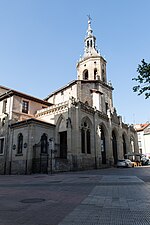La Florida (park)

La Florida is a park in Vitoria-Gasteiz, Álava, Spain. It was built between 1820 and 1855 in neoclassical style by the architects Angel Chavez, Juan De Velasco, Ramón Ortés De Velasco and Manuel Arana. The birth of Florida is dated 1820 when they built the existing ring that surrounds the music kiosk. For the actual 32,454 square meters land used the former convent of Santa Clara, and as much as planners have insisted later, there is nothing similar in the new green spaces in Vitoria. The park is oval and is crossed by two main roads that divide it into quadrants. The roads are perpendicular to each other and intersect in a large circle at the middle of this space. In this circular space is a metal kiosk built in 1890. Each of the squares of the area is bordered by low walls of carved sandstone, which also have small crossed rail-shaped arches.
Excerpt from the Wikipedia article La Florida (park) (License: CC BY-SA 3.0, Authors, Images).La Florida (park)
Floridako ibilbidea/Paseo de la Florida, Vitoria-Gasteiz Zabalgunea/Ensanche
Geographical coordinates (GPS) Address Nearby Places Show on map
Geographical coordinates (GPS)
| Latitude | Longitude |
|---|---|
| N 42.84361 ° | E -2.67611 ° |
Address
Ignacio Aldekoa Kultur Etxea
Floridako ibilbidea/Paseo de la Florida 9
01005 Vitoria-Gasteiz, Zabalgunea/Ensanche
Autonomous Community of the Basque Country, Spain
Open on Google Maps











